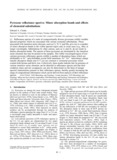Pyroxene reflectance spectra: Minor absorption bands and effects of elemental substitutions
Metadata
Show full item recordAuthor
Cloutis, Edward A.
Date
2002-06-13Citation
Cloutis, E.A. (2002) Pyroxene reflectance spectra: Minor absorption bands and effects of elemental substitutions. Journal of Geophysical Research - Planets,107, 5039, pp. 6-1 - 6-12. DOI: 10.1029/2001JE001590.
Abstract
Reflectance spectra of a suite of compositionally diverse pyroxenes exhibit variable spectral properties which are associated with various elemental substitutions. Those associated with transition series elements, such as Cr, Ti, V, and Mn, give rise to a number of minor absorption bands in the visible spectral region and, in some cases (e.g., Mn), at longer wavelengths. Substitutions by other cations, such as Li and Zr, do not result in distinct absorption bands. The spectra of these pyroxenes are dominated by the transition series elements that may be present in the samples. The visible wavelength region of low-calcium pyroxene reflectance spectra exhibit a number of absorption bands which are attributable to Fe2+ spin-forbidden crystal field transitions. Fe2+-Fe3+ intervalence charge transfer absorption bands near 0.77 μm are common in terrestrial pyroxenes which contain both ferrous and ferric iron. Collectively, these results indicate that the presence of various transition series elements can be detected in reflectance spectra and that their oxidation states and site occupancies can also be determined on the basis of unique
spectral characteristics present in their reflectance spectra, thereby greatly increasing the range of compositional information which can be derived from analysis of their reflectance spectra.

